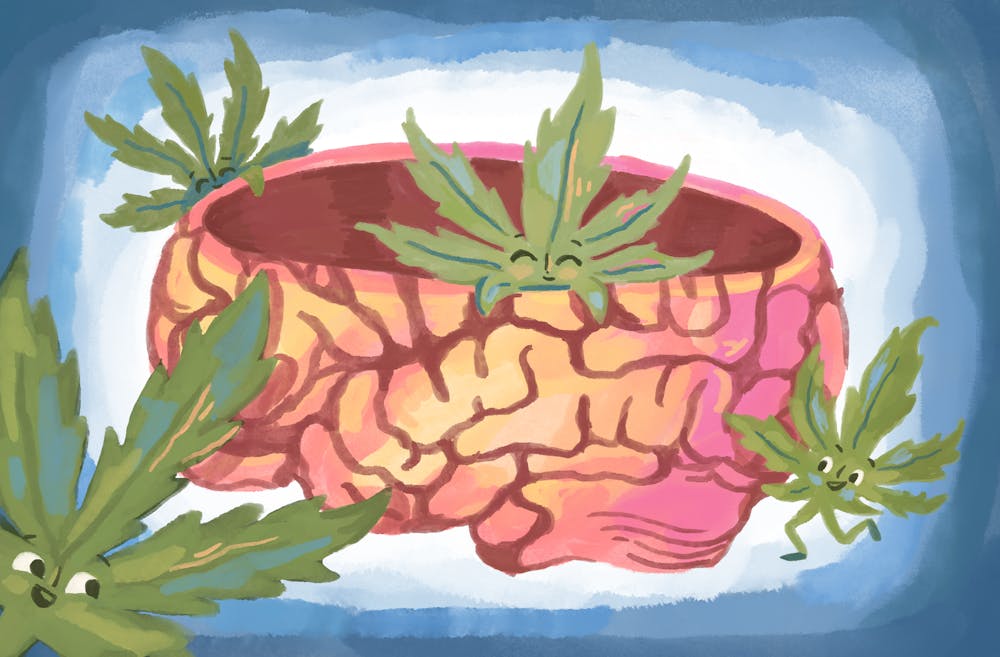This is the fourth in a series of articles about the science of various aspects of college life.
Whether you’ve heard it referred to as weed, Mary Jane, pot, reefer or marijuana, cannabis use is prevalent among college students on College Hill.
The drug will be more prevalent this Sunday, as Brunonians celebrate 4/20 — an unofficial Brown holiday — marked by thousands of students smoking it on the greens at 4:20 a.m and p.m.
According to The Herald’s Spring 2024 poll, 63.24% of Brown students have used cannabis in some form — a figure that climbed from 53% among the class of 2027 to 75% among the class of 2024. That’s notably higher than the national adult average of 50%, based on data from a Pew Research study.
But Alexander Sokolovsky, an assistant professor of behavioral and social sciences, said that 50% is around average for cannabis use among university students.
“From the statistics that I’ve seen, I wouldn’t say that Brown is way out of the distribution in terms of the prevalence of cannabis use on campus,” Sokolovsky said, especially because R.I. law permits recreational use for adults aged 21 and over.
But what chemical interactions are at play that make this intoxicant so popular?
The Cannabis sativa plant — the source of marijuana — produces a “high” comparable to the effects of alcohol or mild psychedelics, depending on the dose and strain.
Although the cannabis plant contains over 400 natural compounds, delta-9-tetrahydrocannabinol — also known as THC — is the primary chemical responsible for the psychoactive high associated with marijuana. Cannabidiol, known as CBD, another major component of the plant, is non-intoxicating and does not produce a high.
Marijuana can be ingested via smoking, vaping, eating edibles and other forms. Once consumed, cannabis enters the bloodstream and makes its way to the brain. There, it primarily binds to CB1 and CB2 receptors, which are G-protein coupled receptors. These are part of the endocannabinoid system — a complex network that helps regulate pain, sleep, hunger and emotions, according to a study by Wake Forest University researchers.
Cannabis also affects the release of neurotransmitters, including gamma-aminobutyric acid and glutamate, which play a role in regulating mood, anxiety and cognition,
But is cannabis safe to use, and is it addictive?
The question of safety is a nuanced one, Sokolovsky said.
“That risk needs to be evaluated comprehensively in light of what the benefits and the risks are,” he said. For someone replacing alcohol with cannabis, the switch may present a safer alternative. For those using cannabis in addition to alcohol, “that is not necessarily safer,” he cautioned.
Cannabis triggers the release of dopamine, which creates a reinforcing effect that can lead to addiction, according to a review in the Journal of Neuroimmune Pharmacology.
Regular users develop increased tolerance over time and experience withdrawal symptoms when their usage stops, Sokolovsky said.
Cannabis “has all the features of other substances that people can become addicted to,” Sokolovsky said.
“There’s lots of people who think cannabis is beneficial for sleep,” he said, adding that “the human body develops a tolerance for those in about four days.”
The more people escalate their use of cannabis to help with sleeping, the more they become reliant on the drug and stuck in a “constant cycle of growing tolerance,” he said.
Developing increased tolerance is just one aspect of cannabis use disorder. According to Sokolovsky, it is important that as cannabis becomes legalized throughout the U.S., lawmakers must be “cautious” with protecting those who may become addicted to the drug.
One Brown sophomore, who spoke to The Herald on the condition of anonymity, said he began smoking cannabis at 14 years old. He “was pretty consistently smoking cannabis” from when he was 14 to the end of his first year at college. But he has since quit the drug, citing “brain fog” and the expenses of the drug. He added that he “just got bored of it.”
“I don’t think it’s like a harmful drug, but I think it’s a drug that sort of hijacks your brain’s dopamine,” he said.
The student stopped consuming cannabis after 4/20 last year. “I just completely burnt myself out for the next three days, my brain wasn’t working at all,” he said, but he is considering partaking this Sunday. “I have no issues with it. I think it’s fun.”
Another sophomore, who also spoke to The Herald on the condition of anonymity, smokes “most weekends” and sometimes even during the week, but told The Herald that he is careful to use cannabis “purely recreationally” and not “as a coping mechanism.”
The student said that smoking makes him feel “slower” and more free to “do silly, goofy stuff.” He added that smoking sometimes creates “a sensation kind of like sinking into the couch” and makes it “more enjoyable and more immersive” to listen to music.
He views weed “pretty similarly to alcohol” in that “maturity to be able to determine where your line is and what is responsible and what works for you” should be a major component in the decision to consume cannabis.
“It can be a fun thing, it can be a social thing and it can be like a positive thing in your life,” he added. “But also, it’s very easy to fall into abuse, whether that’s through addiction or through … the people that you surround yourself with.”
Additional reporting by Elise Haulund.

Leah Koritz is a senior staff writer covering science & research. Leah is from Dover, Massachusetts and studies Public Health and Judaic Studies. In her free time, Leah enjoys hiking, watching the Red Sox and playing with her dog, Boba.





